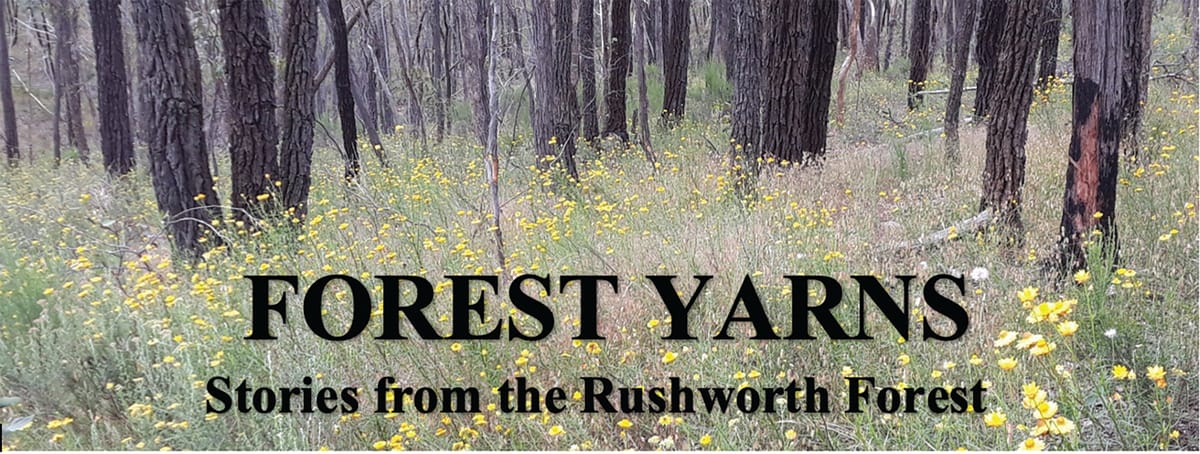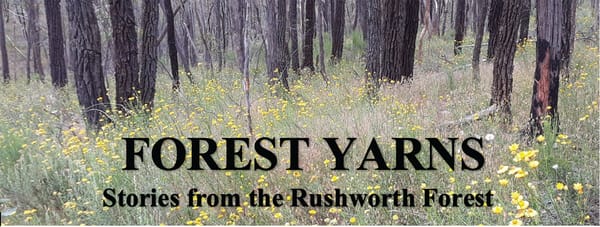Sleeper hewing offcuts
Tony Ford

Following are some snippets of information taken from newspapers in the period between about 1880 and 1940. Most mention a person or people who worked in the sleeper hewing industry in the Rushworth forest.
At the Centennial International Exhibition held in Melbourne, Angus Cameron of Whroo won a prize for his railway sleepers. (The Australasian 9/2/1889)
Two local saw millers each won a contract to supply 10,000 sleepers to the Railways Dept in April 1892 – Taylor Bros at 2/63/4 per sleeper (25c) and W J Mason and Wooley (sic – probably Dooley) at 2/5. (The Argus 2/4/1892)
Messrs Mason and Dooley, and the Taylor Bros of Rushworth submitted letters in support of a meeting of sleeper hewers at Heathcote. They advised that they were willing to aid the movement “by every means in their power”. (McIvor Times 26/4/1895)
William McNamara, the forest officer in charge at Rushworth, set up a sleeper hewers’ Bushmen’s Corps Fund for soldiers at the South African war. McNamara was the father of Frank McNamara, the Rushworth man who later won a VC in World War 1. The idea was that each sleeper hewer would donate one sleeper at the next passing (inspection) of sleepers day, valued at 3/3 each. It was estimated that at the time there were about 200 sleeper hewers in the Goulburn Valley. (Shepparton Advertiser 6/3/1900)
Sleeper hewing contest in Echuca. Fastest time was eight minutes achieved by R Flower. You would assume that the timber had already been cut roughly to size before the event. (Numurkah Leader 26/11/1903)
Inspector of Forests at Heathcote, Mr Code, was advocating that the Moormbool Forest be closed to sleeper hewers for fifteen years. Needless to say, that was an unpopular statement. (McIvor Times 11/2/1904)
Death of Alexander Spence, 54, former secretary of the branch of Sleeper Hewers and Sawmillers Employees Association in Rushworth. He had lived in Rushworth for over 50 years, having arrived as a two-year-old. He left a widow and a large family of seven girls and one boy. (McIvor Times 8/8/1909 and Murchison Advertiser 2/7/1909)
Per secretary Mr James Bailey: “The Bailieston Branch of the Federated Timber Workers held their half yearly meeting here on Saturday…President Mr Smith being in the chair. It was one of the largest meetings held here, the room being crowded. Members were present from Whroo, Nagambie and Graytown. The sleeper hewers are very much hurt at the drastic measures taken by the Forest Department in regard to their working in the forest.” (McIvor Times 25/7/1912)
The sleeper hewers of Bailieston wrote to the Shire Council (per Mr F J Le Deux) requesting its support for an approach to the Conservator (of Forests). They wanted permission to cut out trees that were “faulty” or undersized. Crs Gunn and Brisbane were appointed to be part of the deputation to Melbourne. (Murchison Advertiser 7/5/1915)
A meeting of sleeper hewers was to be held at Le Deux’s wine cafe, Bailieston, on Saturday, 22nd inst., when important business was to be discussed. (Murchison Advertiser 14/6/1918)
The local member, Mr Coyle MLA requested that that the Forests Minister issue some more licences so that the unemployed might be able to find work hewing sleepers in the Rushworth forest. (Sun News Pictorial 29/3/1930)
It was claimed that in most cases the men hewing sleepers in the Rushworth forest had to travel ten to sixteen miles just to get to their work sites. For most, this meant walking or riding a bike, then camping out during the week. (The Argus 28/5/1930)
Two sleeper hewers from Rushworth, J Thompson and W Francis, were returning home from work and found a kerosene tin by the road with “Help” scratched on it. They then found and rescued a bloke called Fitzgibbon, who had got lost in the bush walking to Heathcote. (The Age 29/11/1933)
Rushworth:Friday. Hiram McNicol, sleeper hewer, cut the back of his hand severely, severing the sinews, while barking a log. With the assistance of a friend, he tied up the wound and then cycled ten miles to Rushworth, where he arrived in a condition of collapse. Several stitches had to be inserted in the wound and the sinews tied. (The Argus 18/8/1934)
The Moormbool Forest, covering an area of 23 square miles, gives employment to a large number of sleeper hewers and posts and rails cut from ironbark and box trees in this area are sent all over the State. (The Age 19/7/1939) ( Ed. this is an inaccurate statement with regard to sleeper hewers at the time. Only a handful were left by this time.)










